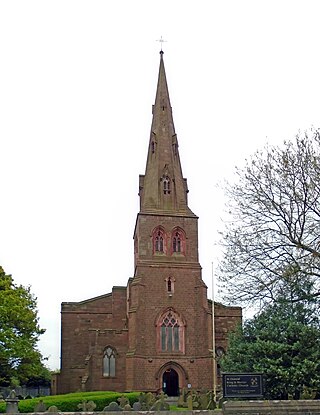Related Research Articles

The Hall of Memory is a war memorial in Centenary Square, Birmingham, England, designed by S. N. Cooke and W. N. Twist. Erected 1922–25 by John Barnsley and Son, it commemorates the 12,320 Birmingham citizens who died in World War I.

The Greek Orthodox Church of St Nicholas is a Grade II Listed building in Toxteth, Liverpool, situated at the junction of Berkley Street and Princes Road. Built in the Neo-Byzantine architecture style, it was completed in 1870. The architects were W. & J. Hay and the church was built by Henry Sumners. It is an enlarged version of St Theodore's church in Constantinople.

Norwegian Fishermans' Church in Liverpool, England, is one of 29 churches organised by Sjømannskirken, a voluntary organisation serving the religious needs of Norwegians abroad on behalf of the Church of Norway.

Norbury is a village and civil parish in the Borough of Stafford, in west Staffordshire, England. The population as taken at the 2011 census was 371.

Coade stone or Lithodipyra or Lithodipra is stoneware that was often described as an artificial stone in the late 18th and early 19th centuries. It was used for moulding neoclassical statues, architectural decorations and garden ornaments of the highest quality that remain virtually weatherproof today.

The Gas Retort House at 39 Gas Street, Birmingham, England is the last remaining building of Birmingham's first gas works.

St Bede's Church is in Appleton Village, Widnes, Cheshire, England. It is an active Roman Catholic parish church in the Archdiocese of Liverpool. The church is recorded in the National Heritage List for England as a designated Grade II listed building.

St Andrew's Church, Langar-cum-Barnstone, is a parish church in the Church of England in Langar, Nottinghamshire. It is Grade I listed as a building of outstanding architectural or historic interest.
Adugak Island (also spelled Adougakh, possibly from Aleut: Adudak; is a small island in the Fox Islands group in the Aleutian Islands of southwestern Alaska. It is about 1.2 miles long and is located 5.0 miles off the northwest coast of Umnak Island.

Deeping St James Priory was a priory in Deeping St James, Lincolnshire, England. It was a dependency of Thorney Abbey.

Christ Church is in Lady Lane, Croft, Cheshire, England. It is an active Anglican parish church in the deanery of Winwick, the archdeaconry of Warrington, and the diocese of Liverpool. Its benefice is united with that of Newchurch. The church is designated by English Heritage as a Grade II listed building. It was a Commissioners' church and had received a grant for its building from the Church Building Commission.

The Welsh Presbyterian Church is in St John Street, Chester, Cheshire, England. The church was built in 1866, and designed by W. & G. Audsley of Liverpool. It is constructed with a yellow sandstone front, brick sides and rear, and a slate roof. The plan consists of a simple rectangle, with an apse at the east end, and a narrower single-storey narthex at the west (entrance) end. The narthex is supported by octagonal piers at the corners and two granite columns between them. On each side of the narthex is a lancet window. Above the narthex is a large rose window, with a lancet window above, and a cross finial on the gable. The church is recorded in the National Heritage List for England as a designated Grade II listed building. The wall and the iron railings and gates in front of the church are included in the listing.

The church of St Peter and All Souls is a Roman Catholic church in Peterborough, on Park Road, north of the city centre. It has been part of the Diocese of East Anglia since 1976, having fallen under the Diocese of Northampton from its building in 1896 until then. St Olga Ukrainian Catholic Church is a Ukrainian Catholic mission that is part of the church.

The Church of Our Lady of Reconciliation is a Roman Catholic church in Eldon Street, Vauxhall, Liverpool, Merseyside, England. It is recorded in the National Heritage List for England as a designated Grade II listed building.

St Oswald's Church is a Roman Catholic parish church in St Oswald's Street, Old Swan, Liverpool, Merseyside, England. It is an active parish church in the Archdiocese of Liverpool and in St Joseph's Pastoral Area. The church is recorded in the National Heritage List for England as a designated Grade II listed building.
Newry is an unincorporated community in Jackson County, Indiana, in the United States.

The Antelope, now housing a restaurant called Hajee's Spices, is a grade II listed building on the Stratford Road in Sparkhill, Birmingham, England. It opened as a public house called The Antelope in 1924.

St John's Church, Letty Green, is a deconsecrated Gothic Revival church in Letty Green, Hertfordshire, England.

The John Heminges and Henry Condell Memorial is a memorial to the actors John Heminges and Henry Condell – the editors of William Shakespeare's First Folio, published in 1623 – in the former churchyard of St Mary Aldermanbury on Love Lane, London EC2. The memorial is made from pink granite and is topped with a bust of Shakespeare by C. J. Allen, dated 1895.

The Church of St Andrew in Rippingale, Lincolnshire, England, is a Grade I–listed Anglican church. The earliest phase of the church dates back to the mid-13th Century.
References
- ↑ Historic England. "Details from listed building database (1054866)". National Heritage List for England . Retrieved 27 June 2011.
